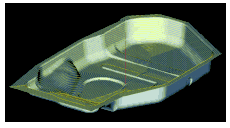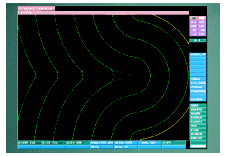Programming For High Speed Machining
You'll have to change your NC programming strategy for high speed machining. Here are some quick tips, and some features to look for in your CAM system.
Share




Programming NC code for high speed machining takes more than just plugging in different numbers for speed, feed, and depth of cut. NC programmers must alter their overall machining strategy to construct tool paths that prove to be efficient, accurate, and safe, and that result in the desired surface finish. It is therefore critical to think carefully about the ramifications of each cut in the machining process, and it certainly helps if the CAM system has features that lend themselves to this process.
Because feeds and speeds are so much higher, programmers must anticipate how the cutting tool is to engage the material. Besides using smaller stepovers and depths of cut, it is important to avoid sharp changes in direction when possible. Sharp turns are slow to execute, create jerky movements that mar surface finish, and may even result in gouging due to over-travel or undercutting external corners. Particularly in 3D contouring, it often makes sense to generate intricate details or corner cuts in separate operations rather than try to generate all features with parallel zigzag, unidirectional, or other generalized cuts.
Gentle entry cuts are advisable. Also try to minimize as much as possible the need for the tool to exit and re-enter the material. As such, ramping from one machining level down to the next is better than plunging. It is also important to maintain constant cutting conditions wherever possible, because variations in cutter load can cause tool deflections that serve to diminish accuracy, surface finish, and tool life. This includes maintaining consistency of the chip load and of the profile of cutter-to-material contact at a given feed rate, and slowing the feed as the tool encounters excess material. In many cases it makes sense to "pre-relieve" corners so that a finishing cutter traveling at high speed doesn't suddenly encounter a heavier chip load as it comes into the excess stock left in the cut by a prior, larger radius tool.
In general, the simpler the cuts, the better, because that will more likely allow the process to operate at maximum feed rates, not having to slow down for dense clusters of data points or abrupt changes in direction. In zigzag cuts, connecting each successive pass with a looping motion likewise will minimize the sharp changes in acceleration and deceleration required to execute a square end.
Knowledge Based Systems
Until fairly recently, the NC programmer was mostly left to his own devices to discern these and other effective cutting strategies, and then turn them into accurate tool paths. But that is changing rapidly as some CAM developers are coming to a deeper understanding of the high speed machining process and incorporating that knowledge into their systems.
One of the most important developments now being offered by several CAM developers is "remaining stock analysis"—that is, the ability of a CAM system to "know" precisely where the stock is after each cut. This is the key to achieving the constant cutter load that is so important to the success of a high speed machining process.
But that's only the beginning, as some knowledge based systems are aimed at much higher levels of automation. For instance, according to Rag Khoshoo, head of CAM development at EDS Unigraphics (Maryland Heights, Missouri), that company is working on capturing a range of effective high speed machining techniques based on "Joint Application Development" forums with leading companies in the automotive, aerospace, die/mold, and machine tool industries. This is leading to the development of software that incorporates a range of best-practice high speed machining methods. For instance, roughing and semi-finishing routines can be generated that anticipate the stock requirements of high speed finishing. Then finishing passes can be automatically generated that more consistently result in the required levels of accuracy and surface finish.
Longer term, Unigraphics is looking to imbue the software with an even broader "understanding" of high speed machining. That's leading to powerful new capabilities to automatically analyze remaining stock and target surfaces in order to discern and execute appropriate machining strategies. Such knowledge-based systems may eventually go far beyond the management of tool and workpiece geometry and also take into account such process variables as tool deflection, machine tool characteristics, and more.
Dan Marinac, president of Cimatron Technologies (Burlington, Ontario, Canada), sees CAM development for high speed machining in similar terms, though he is focused just on die and mold machining. "We've keyed on three areas," he says. "First is to control the chip load according to the constantly changing condition of the material. Second is to round all sharp motions and small moves [so as not to force the machine into unnecessarily abrupt changes in direction]. And third is to handle open and semi-open volumes in such a way as to minimize the need to exit and re-enter the material."
The key to controlling chip load is the system's ability to constantly analyze the profile of the cutter's engagement with the material. As Cimatron's NC applications manager Uri Shakked puts it, "To fully utilize the machines and tools, one must ensure that the speed and feed fit the volume of material to be removed and the slope of the surface. The contact point between the tool and material varies according to the slope, as well as the effective tool radius."
To more broadly and automatically apply machining strategies, Mr. Shakked contends that a system must be able to work with what Cimatron refers to as "equi-technological areas." That means the system should have the ability to automatically identify areas of a core or cavity that are similar enough to warrant a specific machining strategy, and allow users to define that strategy as they please. Once that's done, all sorts of possibilities to further automate programming emerge.
Key Features
In time, knowledge based systems may well automate virtually all of the process planning and programming for high speed machining. For now, though, there is no substitute for programmers understanding the high speed machining process. And it will certainly help to know what kinds of CAM functionality will make both the NC programming and the machining more effective.
While finishing tends to get all the glory, proper semi-finishing cuts can be just as important to the total success of the process. According to Lynn Hock, vice president of CAM developer Open Mind Software (Madison Heights, Michigan), these are some particularly important capabilities to look for:
- Pencil milling automatically cleans up corners or concave fillets so that there is uniform stock left at surface intersections. Relieving the larger volume of material allows for less tool deflection and noise when cutting corners.
- Rest milling is similar to pencil milling in that it identifies all areas that were not cut based on one tool size, and automatically cuts only those areas with a smaller tool. The difference is that rest milling can cut anywhere, not just corners.
-
Z-level spiral milling allows the tool to spiral down in Z to prevent the need for sharp movements.
Once the semi-finishing cuts are complete, there are still other CAM features that Mrs. Hock suggests will result in a more efficient process or better quality:
- True scallop machining calculates the stepover distance normal to the surface rather than normal to the tool vector. This will keep cuts equidistant from each other regardless of the surface curvature, and will result in a much more consistent chip load on the cutter, particularly as the surface curvature is changing from a more vertical orientation to horizontal, or vice-versa.
-
XY optimization automatically "re-machines" remaining material at a 90-degree angle to the original cuts in order to remove all the remaining scallops. This selective creation of tool paths saves having to re-machine the entire workpiece at 90 degrees or having to manually set boundaries in CAM to smooth the required surfaces.
And extremely important, automatic gouge protection is necessary for the sake of both accuracy and safety, because gouges may irreparably damage some workpieces and cause dangerous catastrophic tool failures at high surface speeds. This requires an accurate and continuous math model of the underlying surface geometry, as well as high-functioning tool path generating algorithms to ensure that those surfaces are not violated.
Tool path verification capabilities are also important, allowing programmers to check routines before releasing them to the shop. Additionally, optimization programs are available that can automatically adjust feed rates so that the maximum safe rates are constantly maintained and are tailored to the specific contours of the cut.
Related Content
4 Commonly Misapplied CNC Features
Misapplication of these important CNC features will result in wasted time, wasted or duplicated effort and/or wasted material.
Read MoreHow to Mitigate Chatter to Boost Machining Rates
There are usually better solutions to chatter than just reducing the feed rate. Through vibration analysis, the chatter problem can be solved, enabling much higher metal removal rates, better quality and longer tool life.
Read More5 Tips for Running a Profitable Aerospace Shop
Aerospace machining is a demanding and competitive sector of manufacturing, but this shop demonstrates five ways to find aerospace success.
Read MoreCan AI Replace Programmers? Writers Face a Similar Question
The answer is the same in both cases. Artificial intelligence performs sophisticated tasks, but falls short of delivering on the fullness of what the work entails.
Read MoreRead Next
5 Rules of Thumb for Buying CNC Machine Tools
Use these tips to carefully plan your machine tool purchases and to avoid regretting your decision later.
Read MoreSetting Up the Building Blocks for a Digital Factory
Woodward Inc. spent over a year developing an API to connect machines to its digital factory. Caron Engineering’s MiConnect has cut most of this process while also granting the shop greater access to machine information.
Read MoreBuilding Out a Foundation for Student Machinists
Autodesk and Haas have teamed up to produce an introductory course for students that covers the basics of CAD, CAM and CNC while providing them with a portfolio part.
Read More





















.jpg;maxWidth=300;quality=90)













